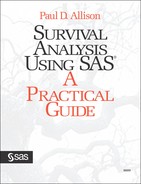An Alternative Approach to Multiple Event Types
The competing risks approach presumes that each event type has its own hazard model that governs both the occurrence and timing of events of that type. The appropriate imagery is one of independent causal mechanisms operating in parallel. Whichever type of event happens first, the individual is then no longer at risk of the other types.
This is clearly a defensible way of thinking about deaths due to natural causes, on the one hand, and forcible removal from power, on the other. It may not be so sensible, however, for the distinction between constitutional exits and nonconstitutional exits. We might imagine that a leader will stay in power as long as his popularity with key groups stays sufficiently high. When that popularity drops below a certain point, pressures will build for his removal. How he is removed is another question, and the answer depends on such things as the constitutional mechanisms that are available and the cultural traditions of the country. In this way of thinking about things, we have one mechanism governing the timing of events and another distinct mechanism that determines the type of event, given that an event occurs.
For an even more blatant example, consider the event buying a personal computer, and suppose we subdivide this event into two types: buying a Macintosh computer and buying an IBM-compatible computer. Now it would be absurd to suppose that there are two parallel processes here and that we merely observe whichever produces an event first. Rather, we have one process that governs the decision to buy a computer at all and another that governs which type is purchased. These kinds of situations arise most commonly when the different event types are alternative means for achieving some goal.
If we adopt this point of view, a natural way to proceed is to estimate one model for the timing of events (without distinguishing among event types) and a second model for the type of event (restricting the analysis to those individuals who experienced an event). For the timing of events, any of the models that we have considered so far are possible contenders. For the type of event, a binomial or multinomial logit model is a natural choice, although there are certainly alternatives.
We have already estimated a logit model for constitutional versus nonconstitutional exits, with the results displayed in Output 6.11. There we interpreted the coefficients as differences in coefficients in the underlying hazard models. Now I am suggesting that we interpret these coefficients directly as determinants of whether a loss of power was by constitutional or nonconstitutional means, given that an exit from power occurred. We see, for example, that those who obtained power by nonconstitutional means are about four times as likely to lose power in the same way. On the other hand, each additional percentage point of literacy increases the odds that the exit will be constitutional rather than nonconstitutional by about 3 percent. Although the effects are only marginally significant, there are consistently positive effects of time on constitutional rather than nonconstitutional changes: older leaders, more recently installed leaders, and leaders who have been in power longer are all more likely to exit via constitutional mechanisms.
We still need a model for timing of exits from power, treating deaths from natural causes as censoring. Output 6.12 shows the results of estimating a Cox model, with the statements:
proc phreg data=leaders;
model years*lost(0,2)=manner age start military conflict
loginc literacy / ties=efron;
strata region;
run;Since nearly half of the exits occurred at 0 or 1 year, I also reestimated the model with the TIES=EXACT option. It took about 35 seconds to estimate (on a 486 machine), and it produced results that were nearly identical to those in Output 6.12.
Output 6.12. Cox Model for Timing of Constitutional and Nonconstitutional Exits
Parameter Standard Wald Pr > Risk Variable DF Estimate Error Chi-Square Chi-Square Ratio MANNER 1 0.373259 0.15841 5.55217 0.0185 1.452 AGE 1 0.017054 0.00572 8.88029 0.0029 1.017 START 1 -0.014880 0.00837 3.15885 0.0755 0.985 MILITARY 1 -0.207177 0.16368 1.60204 0.2056 0.813 CONFLICT 1 0.169923 0.13564 1.56932 0.2103 1.185 LOGINC 1 -0.240164 0.08843 7.37649 0.0066 0.786 LITERACY 1 0.001862 0.00330 0.31750 0.5731 1.002 |
Three results stand out in Output 6.12:
Those who acquired power by nonconstitutional means had about a 45 percent higher risk of losing power (by means other than natural death).
Each additional year of age increased the risk of exit by about 1.7 percent.
A 1-percent increase in GNP per capita yielded about a .24 percent decrease in the risk of exit.
In my judgment, of all the analyses done in this chapter, Output 6.11 and Output 6.12 give the most meaningful representation of the processes governing the removal of leaders from power. To that, we may also wish to add Output 6.7, which shows that only age is associated with the risk of a death from natural causes.
